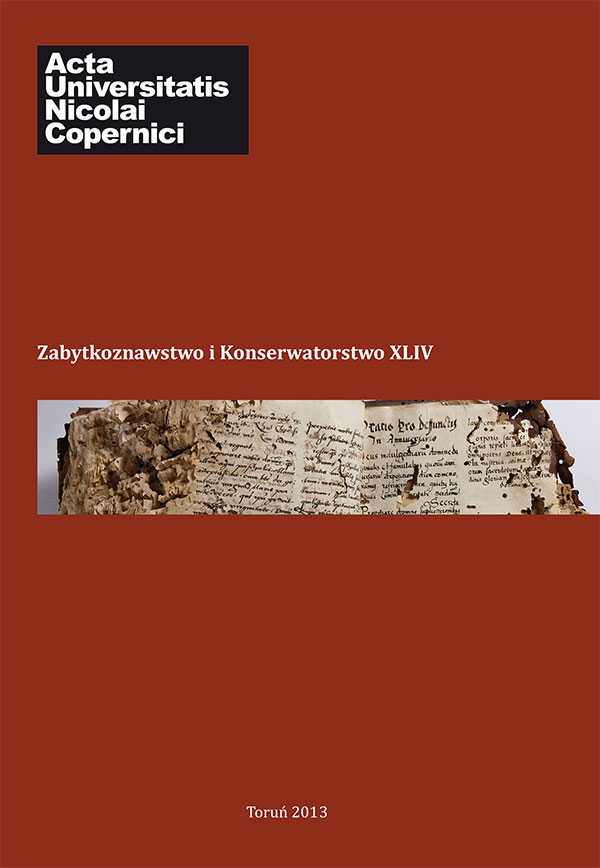Szczęśliwość wieczna królewny Anny Wazówny. W niebie pod kopułą pomnika grobowego
DOI:
https://doi.org/10.12775/AUNC_ZiK.2013.005Słowa kluczowe
Anna Wazówna, pomnik grobowyAbstrakt
The Eternal Bliss is a dream of each believer on crossing the finishing line of his/her earthly journey and entering Heaven in reward for being just. As it comes to the biography of Princess Anna Vasa of Sweden and the events commemorating her that took place in Toruń in 1636, we deal with three visions on the beyond. They are her personal experience of presence in the Third Heaven (1), the vision on her presence in Heaven created by the means of art on her sepulchral monument at the Assumption of the Virgin Mary Church (c. 1636) (2), and the parallel vision constructed during the funeral ceremony (3) and present in a panegyric that situates her in Heavenly Jerusalem, in which her name is written in the Book of Life and she is nourished by the living waters and connected to the Tree of Life.
All endeavours aimed at commemorating Princess Anna Vasa such as funeral ceremony, sepulchral monument and occasional literature are dual in their nature, ie. they are both mournful and distinctly triumphant. Thus on the sepulchral monument, despite its typical gloomy character, there are elements to be found that overtly indicate the state of Eternal Bliss in which the departed Princess is to rejoice. The elements include the monument’s location in the chancel and such its architectural details as a portal in the shape of triumphal arch symbolizing the gate between the earthly and the spirit worlds, a dome as a symbol of Heaven, and a design for the sepulchral sculptures, that contains the lying figure of the Princess (with the eyes open and lost in contemplation of the spirit world; situated beyond the portal-gate and composed within the arch of the portal), and the set of three portal figures, standing for Princess’ earthly achievements and opening the gate to Heaven for her in exchange for her faithfulness to the faith and its articles. The figures include the images of Fides (Faith), Gratitudine (Gratitude) – representing the help to our neighbours, and Vittoria (Victory) – denoting the victory in the earthly and heavenly dimensions.
Pobrania
Opublikowane
Jak cytować
Numer
Dział
Licencja
CC BY ND 4.0. Posiadaczem prawa autorskiego (Licencjodawcą) jest Autor, który na mocy umowy licencyjnej udziela nieodpłatnie prawa do eksploatacji dzieła na polach wskazanych w umowie.
- Licencjodawca udziela Licencjobiorcy licencji niewyłącznej na korzystanie z Utworu/przedmiotu prawa pokrewnego w następujących polach eksploatacji: a) utrwalanie Utworu/przedmiotu prawa pokrewnego; b) reprodukowanie (zwielokrotnienie) Utworu/przedmiotu prawa pokrewnego drukiem i techniką cyfrową (e-book, audiobook); c) wprowadzania do obrotu egzemplarzy zwielokrotnionego Utworu/przedmiotu prawa pokrewnego; d) wprowadzenie Utworu/przedmiotu prawa pokrewnego do pamięci komputera; e) rozpowszechnianie utworu w wersji elektronicznej w formule open access na licencji Creative Commons (CC BY-ND 3.0) poprzez platformę cyfrową Wydawnictwa Naukowego UMK oraz repozytorium UMK.
- Korzystanie przez Licencjobiorcę z utrwalonego Utworu ww. polach nie jest ograniczone czasowo ilościowo i terytorialnie.
- Licencjodawca udziela Licencjobiorcy licencji do Utworu/przedmiotu prawa pokrewnego nieodpłatnie na czas nieokreślony
PEŁEN TEKST UMOWY LICENCYJNEJ >>
Statystyki
Liczba wyświetleń i pobrań: 419
Liczba cytowań: 0



